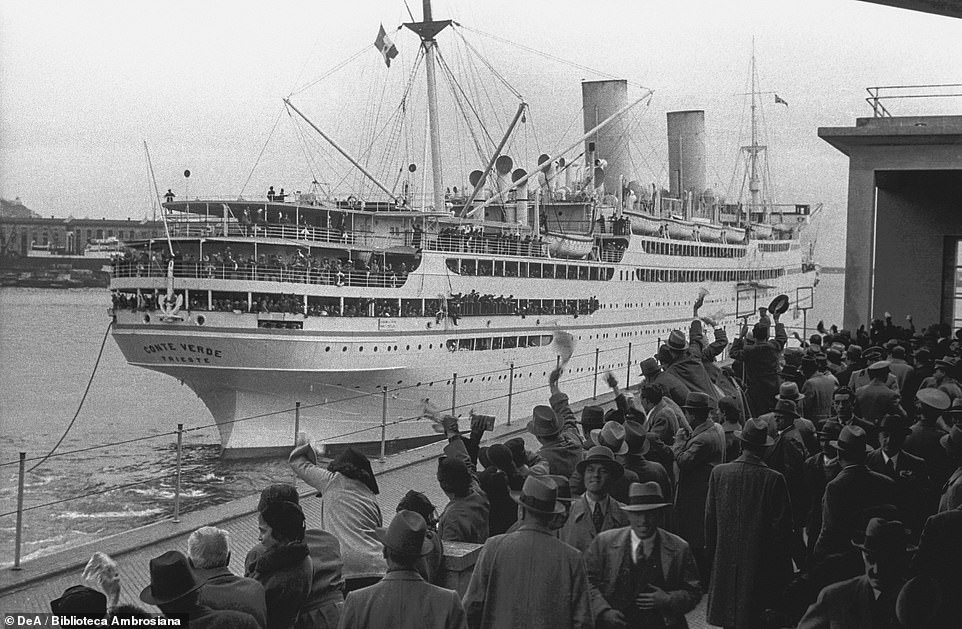Are we in the golden age of sea travel? Or have we left it behind?
These fascinating vintage photographs will no doubt suggest to some that today’s “floating city” cruise ships lack the romance and glamour of the passenger ships of yesteryear. The archive photographs show life aboard the Conte Rosso and the Conte Verde, Italian ocean liners built in Scotland in the early 1920s and designed to carry passengers from From Europe to North and South America.
The Conte Verde measured 180m/590ft long, less than half the length of the world’s largest cruise ship in 2024, Royal Caribbean’s Icon of the Seas (364m/1194ft), but still had room for more than 2,400 passengers across 10 decks and was considered the height of luxury.
First-class passengers enjoyed interiors built by craftsmen and artists brought from Florence to shipyards in Scotland. Even third-class passengers had access to an outdoor swimming pool.
Launched in 1922, the Conte Verde made many memorable voyages across the ocean, including transporting European football teams to the first World Cup in Uruguay in 1930.
Scroll down to see what life was like on these great vessels…
The Conte Verde set sail in 1922 from Genoa, Italy, on its maiden voyage to Buenos Aires, Argentina. Pictured here, the ship departs on a subsequent voyage from Genoa in 1936. Many passengers used the ship to emigrate and may have bid farewell to Europe and their families forever.

Pictured is the dining room aboard the Conte Verde in the 1930s. A Times article, written when the ship was launched in 1923, said that “the richness of artistic detail everywhere (on board the ship) recalls the former splendor of an Italian palace.” The inscription above the door at the back of the room, “A Tavola Non S’Invecchia,” means “At the table, one does not grow old” and reflects the cheerful Italian attitude to food.

This image shows a Thanksgiving buffet for the ship’s first-class passengers in 1930. What might they have enjoyed? Conte Verde menu card In 1939, the ‘New Moon’ cocktail was advertised, which was made with Gordon dry gin, sherry, French vermouth, Angostura bitters, absinthe and a dash of lemon peel. The Conte Verde could carry 450 first-class passengers.

Pictured here is the first class dining room on board the Conte Rosso ocean liner, sister ship to the Conte Verde. It was also famous for its ornate interior furnishings and opened in 1921.

Cooks are pictured in the second-class galley of the Conte Verde in 1930. Second class was the smallest class on board, with room for 200 passengers.

Pictured here are passengers in the ship’s third-class dining room in 1930. The Conte Verde had room for over 1,700 third-class passengers and most of them were people emigrating abroad to start a new life.

This photograph, dating from 1930, shows passengers playing and relaxing on the deck of the Conte Verde. A first-class brochure from 1939 advertises clay pigeon shooting on the ship’s second-class deck.

This image shows the third-class swimming pool of the Conte Verde in 1930. Other passenger activities included ball games, evening concerts and dancing.

Passengers are shown praying on the deck of the Conte Verde in 1930. The journey from Europe to the Americas on an ocean liner took about fifteen days.

The picture shows the operation on board the Conte Verde in 1930. Unlike a cruise ship, ocean liners did not make stops along the route, so sick passengers would not have had the opportunity to get off.

This is the gym on board the Conte Verde’s sister ship, the Conte Rosso, in the 1930s. The Conte Rosso was known for its outdoor dining areas, unusual for the time.

This image shows the French national football team aboard the Conte Verde on their way to participate in the first World Cup in Uruguay in 1930. According to The GuardianLucien Laurent, a French footballer on board, said: “There was no talk of tactics or anything like that, there was no training. It was just running around the deck of the ship. We were running, running all the time. Down below we were exercising – stretching, jumping, running up the stairs, lifting weights.” The Conte Verde carried several other teams to the tournament, including Romania, Brazil and Belgium. England did not take part in the event.

Pictured is Amedeo Pinceti, the captain of the Conte Verde in 1930. The ship had around 400 crew members.

This photograph shows people watching the Conte Verde depart New York in the 1930s. Later in the decade the ship was used to travel between Italy and Shanghai. Many Jewish refugees escaped Europe on the Conte Verde until the route was closed in 1940 when Italy joined the war. The ship was bombed and sunk in the 1940s in Asia and was eventually scrapped in 1949. After World War II, the use of ocean liners declined dramatically due to the launch of faster long-distance flights. Cunard’s Queen Mary 2 is now the only ocean liner still in service.


